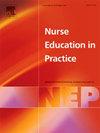Understanding perceptions, attitudes and experiences of nursing students during clinical placement in primary health care settings – A scoping review
IF 3.3
3区 医学
Q1 NURSING
引用次数: 0
Abstract
Aims
Critically analyse literature on undergraduate nursing students' perceptions, attitudes and experiences during Primary Health Care (PHC) placements and identify factors influencing their satisfaction. These insights may improve educational outcomes, shape career intentions and address workforce shortages.
Background
Global nursing shortage, driven by increased demands and high attrition, impacts healthcare worldwide. Australia faces projected shortfalls of 79,473 nurses by 2035, significantly in PHC. Attributing factors include remuneration disparities, inadequate training/mentorship and limited career pathways. Strengthening the PHC nursing workforce is crucial, with undergraduate nursing students providing an important workforce pipeline.
Design/Method
Scoping Review protocol was registered using Joanna Briggs Institute’s framework for scoping review methodology, Preferred Reporting Items for Systematic Reviews and Meta-Analyses extension for Scoping Review’s Checklist and Peer Review of Electronic Search Strategies, were applied. Grey literature was sought. Covidence facilitated article review and extraction, inductive thematic analysis identified key themes.
Results
Four key themes were developed: 1. PHC placements as a learning environment; 2. Skills development and acquisition; 3. Importance of nurse preceptor relationship; and 4. Curriculum structure and preparation.
Conclusions
This review explores nursing students’ experiences in PHC placements and factors influencing satisfaction, while highlighting gaps in optimising placements to better prepare students and strengthen the PHC workforce. Further research is needed on satisfaction, variation in experiences across PHC settings, the impact of preceptor relationships and strategies to strengthen them and stronger integration of PHC content in curricula. Addressing these gaps is essential for aligning education with workforce demands and strengthening student career intentions in PHC.
了解初级卫生保健机构临床实习期间护理学生的看法、态度和经验-范围审查
目的批判性地分析本科护生在初级卫生保健(PHC)实习期间的认知、态度和经历,并确定影响其满意度的因素。这些见解可以改善教育成果,塑造职业意向,解决劳动力短缺问题。由于需求增加和人员流失率高,全球护理短缺影响了全球医疗保健。到2035年,澳大利亚预计将面临79,473名护士的缺口,主要是初级保健。造成这种现象的因素包括薪酬差距、培训/指导不足和职业道路有限。加强初级保健护理队伍至关重要,本科护理学生提供了重要的劳动力渠道。设计/方法使用乔安娜布里格斯研究所的范围审查方法学框架注册范围审查协议,应用系统审查的首选报告项目和范围审查清单的元分析扩展以及电子搜索策略的同行审查。寻找灰色文献。疫情促进了文章审查和提取,归纳主题分析确定了关键主题。结果提出了四个关键主题:1。初级保健实习作为学习环境;2. 技能发展和获得;3. 护师长关系的重要性和4。课程结构和准备。结论本综述探讨了护理专业学生在初级保健实习中的经历和影响满意度的因素,同时强调了优化实习的差距,以更好地为学生做好准备,加强初级保健工作队伍。需要进一步研究满意度、在初级保健设置中体验的变化、师长关系的影响、加强师长关系的策略以及加强初级保健内容在课程中的整合。解决这些差距对于使教育与劳动力需求保持一致并加强PHC学生的职业意向至关重要。
本文章由计算机程序翻译,如有差异,请以英文原文为准。
求助全文
约1分钟内获得全文
求助全文
来源期刊

Nurse Education in Practice
NURSING-
CiteScore
5.40
自引率
9.40%
发文量
180
审稿时长
51 days
期刊介绍:
Nurse Education in Practice enables lecturers and practitioners to both share and disseminate evidence that demonstrates the actual practice of education as it is experienced in the realities of their respective work environments. It is supportive of new authors and will be at the forefront in publishing individual and collaborative papers that demonstrate the link between education and practice.
 求助内容:
求助内容: 应助结果提醒方式:
应助结果提醒方式:


